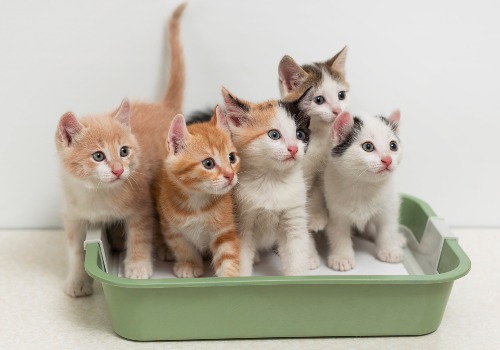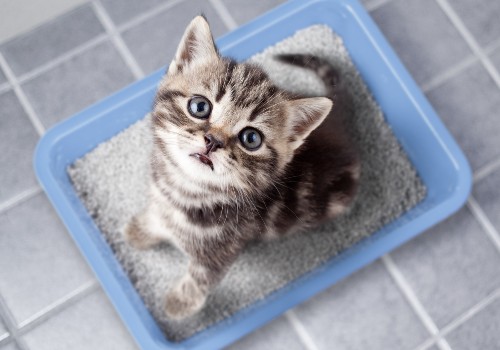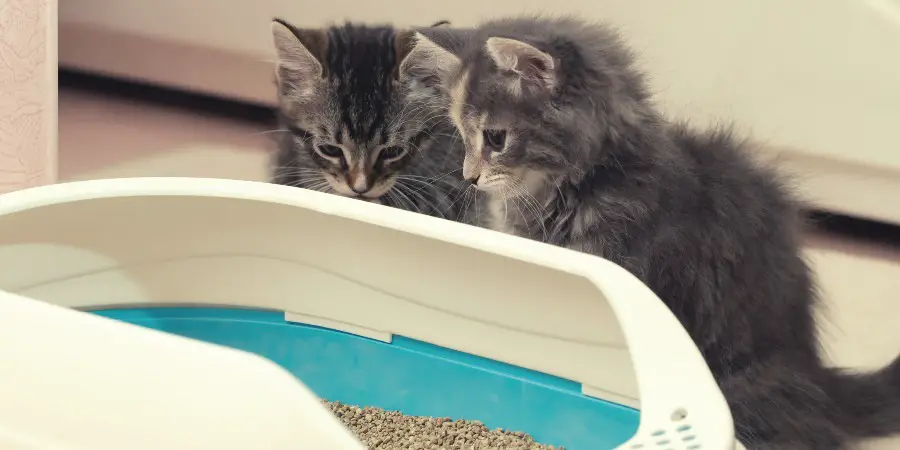Every pet owner is dedicated to providing quality care and love to their animal. Cats especially require a certain level of knowledge and understanding of animal behavior to properly care for them. Unlike dogs who need to be taken on walks, indoor cats use litter boxes stored around the home. Knowing how to best care for your cat and all of their litter box needs is essential to keeping them happy and healthy.
In this article, we’ll cover some litter box fundamentals and then touch on if putting two together is a good idea.
How Many Litter Boxes Do You Need?
There is no hard rule on how many litter boxes are perfect for your cats. Many owners follow the one box per cat plus one extra in their home. Just one box isn’t enough for a cat, especially if the home has more than one floor. Cats can stop using a litter box for a variety of reasons, from not being clean enough to having a strong territorial odor from another cat. Having more than one box in strategic areas around the home minimizes the possibility of accidents and acting out.
Cats have been known to use one litter box for urination and another for feces. They may want to use the box furthest away from the occupants in the house, desiring privacy, or to be entirely left alone. Multiple litter boxes help your cats feel more secure in their home. Litter boxes are the best ways for cats to healthily mark their territory without urinating on furniture or important household items.
What to Keep In Mind for Multiple Cats

Multiple litter boxes are essential when you have more than one cat in the house. Cats can become territorial of their litter boxes, avoiding or even refusing to use a box that’s been used by another cat. More than one box around the home also minimizes how often they will have to be cleaned. Scooping out dirty litter is arguably one of the worst responsibilities that comes with having cats.
Families don’t usually have the time to constantly clean the boxes every day, so more than one gives every cat their best option. You’ll likely notice signs of territorial cats in how they act with each other and if they engage in activities together. It’s best never to force a cat to share and to ensure every animal has their own interrupted access to food, toys and a litter box.
Best Types of Litter
When purchasing cat litter, always thoroughly research new brands and have an idea of what your cat will use. Many pet owners use clay litter for their litter boxes because it naturally draws in cats. Clumping is a good option for many adults cats and offers easy cleaning. Non-clumping requires more frequent and thorough cleanings and is the better alternative for kittens.
Silica crystals often last longer than clay and control overall odor better. This is typically the more expensive option and can be harmful if your cat ingests it in high quantities. Pine, wheat and corn litters are natural alternatives that have very low amounts of dust. They’re biodegradable and have excellent urine odor control. However, they typically don’t clump, and your cat can have allergies to these options. You should base your litter option on your cat’s preferences, allergies and how often you’ll be able to clean the litter boxes.
What Size Litter Boxes Are Best?
[amazon bestseller=”cat litter box”]
Your cat needs enough room to freely turn around and dig in the litter. If the box is too small or cramped, they’re more likely to make a mess or to avoid the box altogether. Larger boxes often offer helpful features like lids for privacy and scent filters. They’re also much more durable and will withstand daily use. Always opt for bigger boxes to avoid frequent messes and give your cat a safe area where they’re fully comfortable.
Can You Put Two Litter Boxes Next to Each Other?
You can definitely put two litter boxes together, but it’s important to keep in mind the size of your home and how many cats you have. For example, for a bigger home with multiple floors, you’ll better suit your cats’ needs by separating the boxes into different areas, ensuring no matter where they are they have easy access to a litter box. By keeping the boxes together, they act as one toilet area rather than two separate ones. This will likely lead to territorial issues if there are no other nearby litter boxes.
For pet owners living in studio apartments, there are likely very few areas that can fit a litter box. Don’t feel bad about having the only litter boxes close to each other out of necessity. Having multiple litter boxes is more essential than spacing them out if necessary. Concealing the litter boxes can maximize space in a smaller living environment while providing your cats with their basic needs.
Each cat is different in the space it needs to mark territorially. Cats with good relationships can often share litter boxes easily. Monitor your cats to determine the best solution for your household. Identify tension around the litter boxes or food bowls and work to separate items to ensure every cat is happy. Stress and anxiety can develop silently between cats before erupting in fights, irritation and accidents around the home.
Where Do You Put My Litter Boxes?
Litter boxes should be spread around a home to give your cats as much bathroom access as possible. Focus on putting boxes in spots that are socially significant to your cats. Felines want a safe, clean area to use the bathroom that isn’t in the way of too much foot traffic or noise. The litter boxes also shouldn’t be tucked away completely in the dark as cats can’t see in pitch-black conditions.
Avoid putting any litter boxes in rooms that are very noisy or busy. Your cats also won’t want to use the bathroom too close to their food or water bowls. Finding the perfect places for litter boxes in your home often requires some creativity like concealed boxes or those that can double as shelves. Giving your cats litter boxes they want to use keeps the home cleaner and your felines happier. Consider the conditions you want in your own bathroom and utilize that insight to better care for your cats’ litter boxes.
How Often Should You Clean My Litter Boxes?
[amazon bestseller=”cat litter scoop”]
Your routine will vary greatly on what type of litter you use and how many cats are in the home. Many owners clean their litter boxes once a week if they have one cat. You’ll need to clean it every couple of days if you have more. For natural litters like pine, wheat and corn, the urine will be soaked up but feces will sit on the litter and create a lasting odor. These litters will need to be scooped daily for feces and replaced weekly at most with new, fresh litter.
You should be dumping all the litter and cleaning the box with dish soap at least once a week or every couple of weeks. This minimizes odors that stick to the box itself, stinking up the home. Litter boxes should be replaced about once a year if they’ve been used normally or more frequently if you have a cat with particularly sharp claws. When they scratch the sides when using the litter box, they create grooves where contaminants and odor can sink in.
Weekly washings can minimize the odor but the box will eventually reach a point where it never seems to be completely clean. Preparing ahead of time with extra litter boxes will keep your cats happy and the home smelling clean and fresh.
Will My Cat Be Able to Find the Litter Box Once It’s Been Moved?

Felines are incredibly intelligent animals with strong noses. They’ll be able to easily find the location of the new box but might not want to use it at first. Cats like to have a routine and a firm grasp of their surroundings. Your cat may refuse to use the new litter box or show signs of displeasure at the change.
You can mitigate their stress and confusion by moving an extra box to the new location before moving the old one. This allows them to get used to the location before having to completely rely on it. When they’ve acclimated, you can remove the litter box from the old location. If your cat urinates in the area where the box used to be, it’s more likely they’re upset and want you to know rather than they’re confused and can’t find the new box.
Conclusion
Putting two litter boxes next to each other is a great way to provide your cats with extra room to do their business. There should still be other boxes around the home so each cat can have a private space to fulfill territorial needs. By recognizing your cats’ needs, you can find the root cause of accidents in your home and create a happier and healthier environment for your animals.
Can I Put Two Litter Boxes Next to Each Other? (Video)
"In ancient times cats were worshipped as gods; they have not forgotten this."
-- Terry Pratchett





